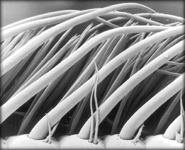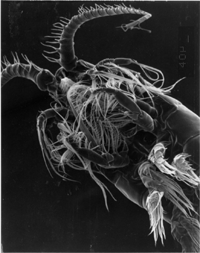Media coverage of our research
Zooplankton surfing in turbulence
Articles
- Wright, K. (2022) Turbulence-surfing plankton can double their speed. Physics Magazine 15: 122. Link to article
Take-off by mosquitoes
Articles
- Knight, K. (2017) Inside JEB:Softly, softly, mosquitoes outwit human victims. Journal of Experimental Biology 220: 3605. PDF
- Quintanilla, M. (2017) The physics of mosquito takeoffs shows why you don’t feel a thing. ScienceNews 92: 13. Link to article with video PDF
- Sanders, R. (2017) A mosquito's secret weapon: a light touch and strong wings. Berkeley News. Link to article with video PDF
- Sanders, R. (2017) A mosquito's secret weapon: a light touch and strong wings. Phys.org. Link to article with video
- Smith, B. (2017) Understanding how mosquitos take off so quickly could help inform drone design. Australian Broadcasting Corporation - News - Science. Link to article video
- Pierre-Louis, K. (2017) Mosquitoes evolved to fly away with a belly full of your blood—without you ever noticing. Popular Science. Link to article with video PDF
- Weisberger, M. (2017) How Blood-Bloated Mosquitoes Stealthily Avoid a Swat. Live Science. Link to article with video
Smelling with hairy noses
 Frame of a video of a robotic lobster in turbulent water flow flicking its antennule (nose) in filaments of odor
Frame of a video of a robotic lobster in turbulent water flow flicking its antennule (nose) in filaments of odor
Print Articles
- "Editor's Choice" section of Science: Fanning the Flame. Science 289: 2007. (2000).
- Fountain, H. Danger Sniffer. New York Times (Science section). Tuesday, December 11, 2001.
- Summers, A.(2002) Hairy noses. Natural History February 2002: 70-71.
- Mead, K. S. (2002) Using lobster noses to inspire robot sensor design. Trends in Biotechnology 20: 276-277 (DOI: 10.1016/S0167-7799(02)01979-0).
- Levy, K. (2003) Get a whiff of this. Berkeley Science Review 3: 11-12.
- Mackenzie, D. (2007) From flu to lobsters to DNA. Emissary - Mathematical Sciences Research Institute newsletter. Spring 2007. PDF
Web articles
- Dye, L. (2001) Inspired by nature. ABCnews.com. Link to article
- Ascribe - Public Interest Newswire (2001) Lobster-sniffing study may spawn underwater robots. PDF
- Eurekalert! - News Service of the American Association for the Advancement of Science (2001) Scent of a lobster. Link to article
- Sanders, R. (2001) Lobster sniffing: how lobsters' hairy noses capture smells from the sea. UC Berkeley Campus News. Link to article
- Heuss, C. (2002) Sniff. Sniff. How does a lobster's nose know? ScienceNotes (Online Magazine of the Science Communication Program at UC Santa Cruz). Link to article
- InTech - Online publication of the Instrumentation, Systems, and Automation Society (2002) Lobsters can smell danger.
- Wong, K. M. (2008) Mother Nature's Engineering. ScienceMatters. PDF
- Gosnell, J. (2014) Robotic lobster noses. Canadian Geographic Compass. PDF
- Sharlach, M. (2014) Baby nose hairs. The Scientist Link to article image (PDF)
 Scanning electron micrograph (SEM) of the chemosensory hairs on an antennule (nose) of a spiny lobster
Scanning electron micrograph (SEM) of the chemosensory hairs on an antennule (nose) of a spiny lobster
Television
- Research featured on Canadian "Discover" (January, 2002)
- Work featured on "Tech Live" news show (Tech TV). February 18, 2001.
Radio
- Interviewed on the "Todd Mundt Show" (National Public Radio). January 18, 2001.
- "Quirks and Quarks" (Canadian Broadcasting Corporation's radio science program) 2002.
- "Science Update" (American Association for the Advancement of Science) January 18, 2002.
- BBC Radio 4, "Lobster Surprise". October 18, 2004. Link to RealAudio stream
- Interviewed on the radio about the physics and biology of rocky coasts, the subject of book, Wave-Swept Shore (2006-2007)
Evolution of insect flight
Articles
- Gould, S. J. (1985) Not necessarily a wing: Which came first, the function or the form?
- Natural History 94: 12-25. ("This View of Life" column)
- Lewin, R. (1985) On the origin of insect wings. Science 230: 428-429. ("Research News" section)
- Flights of conjecture. Scientific American 254: 66B. ("Science and the Citizen" section) (1986)
- Morell, V. (1987) The origin of flight. Equinox 32: 13-16.
Radio
- "Quirks and Quarks" (1985) Canadian Broadcasting corporation's radio science program.
Wave-swept marine organisms
 Photograph of waves crashing on large seaweeds on a rocky shore
Photograph of waves crashing on large seaweeds on a rocky shore
Articles
- An article about Koehl's research on sea anemone in waves appeared in Newton (Japanese magazine about science) (March, 1984)
Television
- Koehl appeared on a NOVA television program, "Living Machines" (PBS) (1980)
- "Quantum" (Australian Broadcasting Corporation, television science series) (1992)
Suspension feeding
 SEM of a copepod showing its feeding appendages
SEM of a copepod showing its feeding appendages
Articles
- "Active eating in a syrupy sea", appeared in Science News, (Jan. 17, 1981)
Television
- "Investigating Suspension Feeders", which is part of the series "Biology: Uniformity and Diversity" (British Broadcasting Corporation) (1999)
Women in science
Books
- Schatz, H. (1993) Gifted Women. San Francisco: Pacific Photographic Press. 120 pp.
- Sherrer, B.F. and B.S. Sherrer [eds.] (1996) Notable Women Scientists in the Life Sciences. Westport, CN: Greenwood Publishing. 456 pp.
- Oakes, E.H. (2002) International Encyclopedia of Women Scientists. New York: Facts on File. 448 pp.
- Parks, D. (2005) Nature's Machines. Joseph Henry Press (National Academy of Sciences), and Scholastic.
- Daniell, E. (2006) Every Other Thursday: Stories and Strategies of Successful Women Scientists. New Haven, CN: Yale University Press. 268 pp.
Articles
- Franklin, D. (1991) The shape of life. Discover 12: 10-15. (special issue profiling selected women scientists)
- Yeoman, B. (2008) Lobsta Got to Sniff Dinosaurs Got to Fly. Duke Magazine. September October 2008. PDF
